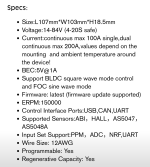Hey, I own a Vsett 10 electric scooter and would like to replace the battery and controller, but I need your help guys 
Now:
60V 28Ah Samsung 18650 (???)
Controller 30-35A x2
Hub motor 60V 1400W (3 mm² cable) x2
Plan:
60V 32Ah Samsung 21700 40T (16s8p)
Flipsky 75100 VESC controller - max continuous 100A x2
New engine power cable 4 mm² + temp. sensor x2
Battery:
Samsung 40T cells seem to be the best choice. Any pros or cons? Which BMS should I choose (most of them are wider than the cell)? If the controller has max continuous power 200A (100A per wheel), the BMS must also have 200A? Because I saw 300A controllers connected to 150A BMS. Confusing
Controller:
I like the Flipsky controller because of its size (11 x 11 x 2 cm) and these based on VESC are the best, right? Has anyone tried to connect a dashboard to it? Any advice? (I think the hardest part for me, including fitting the throttle and brake sensors).
I also considered the Nucular controller, but the waiting time is approx. 7 months. Kelly controllers are kinda big. Stormcore and Trampa are max 60V. Have I missed something? Is there any good kit with dashboard so I don't have to mess with all of this?
I will also have to do a 12V installation to power the lights and horn, but that should be relatively easy. Led flasher for turn signals and just new wires for buttons located on the steering wheel.
Hub motor:
Thicker cable + temperature sensor connected to the controller (if possible?) + ferrofluid statorade to improve cooling and get the maximum out of the motors, because I think they will be the main limitation here?
This is my first time so any advice and ideas are welcome
Now:
60V 28Ah Samsung 18650 (???)
Controller 30-35A x2
Hub motor 60V 1400W (3 mm² cable) x2
Plan:
60V 32Ah Samsung 21700 40T (16s8p)
Flipsky 75100 VESC controller - max continuous 100A x2
New engine power cable 4 mm² + temp. sensor x2
Battery:
Samsung 40T cells seem to be the best choice. Any pros or cons? Which BMS should I choose (most of them are wider than the cell)? If the controller has max continuous power 200A (100A per wheel), the BMS must also have 200A? Because I saw 300A controllers connected to 150A BMS. Confusing
Controller:
I like the Flipsky controller because of its size (11 x 11 x 2 cm) and these based on VESC are the best, right? Has anyone tried to connect a dashboard to it? Any advice? (I think the hardest part for me, including fitting the throttle and brake sensors).
I also considered the Nucular controller, but the waiting time is approx. 7 months. Kelly controllers are kinda big. Stormcore and Trampa are max 60V. Have I missed something? Is there any good kit with dashboard so I don't have to mess with all of this?
I will also have to do a 12V installation to power the lights and horn, but that should be relatively easy. Led flasher for turn signals and just new wires for buttons located on the steering wheel.
Hub motor:
Thicker cable + temperature sensor connected to the controller (if possible?) + ferrofluid statorade to improve cooling and get the maximum out of the motors, because I think they will be the main limitation here?
This is my first time so any advice and ideas are welcome



